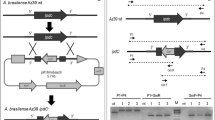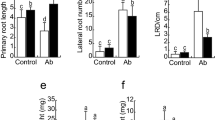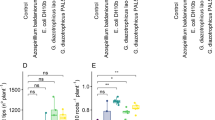Abstract
Auxin production by Azospirillum is believed to play a major role in the observed plant growth promoting effect. By using different genetically modified strains, the contribution of auxin biosynthesis by A. brasilense in altering root morphology was evaluated in a plate assay. Inoculation with the wild type strains A. brasilense Sp245 and Sp7 resulted in a strong decrease in root length and increase in root hair formation. This effect was abolished when inoculating with an ipdC mutant of A. brasilense. The ipdC gene encodes a key enzyme in the IPyA pathway of IAA synthesis by A. brasilense. On the other hand, the observed auxin effect was further enhanced by adding tryptophan, a precursor of IAA, to the plates and could be mimicked by replacing the Azospirillum cells by a particular concentration of IAA. Furthermore, particular mutants (rpoN, scrp) and transconjugants (extra copy of ipdC) of A. brasilense were tested in the plate assay. Together, these results confirm the important role of IAA produced by Azospirillum in altering root morphology and illustrate the power of combining genetic tools and bioassays to elucidate the mechanism of a beneficial Azospirillum-plant interaction.
Similar content being viewed by others
References
Baldani V L D, Baldani J I and Döbereiner J 1987 Inoculation of field grown wheat (Triticum aestivum) with Azospirillum spp. in Brasil. Biol. Fertil. Soils 4. 37–40.
Barbieri P and Galli E 1993 Effect on wheat root development of inoculation with an Azospirillum brasilense mutant with altered indole-3-acetic acid production. Res. Microbiol. 144. 69–75.
Bashan Y and Holguin G 1997 Short-and medium-term avenues for Azospirillum inoculation. In Proceedings of the Fourth International Workshop on Plant Growth-Promoting Rhizobacteria. Eds A Ogoshi, K Kobayashi, Y Homma, F Kodama, N Kondo and S Akino. pp 130–149. Faculty of Agriculture, Hokkaido University, Sapporo, Japan.
Bottini M, Pearce D and Pharis R P 1989 Identification of gibberellins A1, A3, and iso-A3 in cultures of Azospirillum lipoferum. Plant Physiol. 90. 45–47.
Cacciari I, Lippi D, Pietrosanti T and Pietrosanti W 1989 Phytohormone-like substances produced by single and mixed diazotrophic cultures of Azospirillum and Arthrobacter. Plant Soil 115. 151–153.
Costacurta A, Keijers V and Vanderleyden J 1994 Molecular cloning and sequence analysis of an Azospirillum brasilense indole-3-pyruvate decarboxylase gene. Mol. Gen. Genet. 243. 463–472.
Croes C, Moens S, Van Bastelaere E, Vanderleyden J and Michiels K 1993 The polar flagellum mediates Azospirillum brasilense adsorption to wheat roots. J. Gen. Microbiol. 139. 2261–2269.
Crozier A, Arruda P, Jasmin J M, Monteiro A M and Sandberg G 1988 Analysis of indole-3-acetic acid and related indoles in culture medium from Azospirillum brasilense. Appl. Environ. Microbiol. 54. 2833–2837.
Glickmann E and Dessaux Y 1995 A critical examination of the specificity of the Salkowski reagent for indolic compounds produced by phytopathogenic bacteria. Appl. Environ. Microbiol. 61. 793–796.
Horemans S, De Koninck K, Neuray J, Hermans R and Vlassak K 1986 Production of plant growth substances by Azospirillum sp. and other rhizosphere bacteria. Symbiosis 2. 341–346.
Jain D K and Patriquin D G 1984 Root hair deformation, bacterial attachment, and plant growth in wheat-Azospirillum associations. Appl. Environ. Microbiol. 48. 1208–1213.
Jain D K and Patriquin D G 1985 Characterization of a substance produced by Azospirillum which causes branching of wheat root hairs. Can. J. Microbiol. 31. 206–210.
Kapulnik Y, Okon Y and Henis Y 1985 Changes in root morphology of wheat caused by Azospirillum inoculation. Can. J. Microbiol. 31. 881–887.
Martens D A and Frankenberger W T Jr 1994 Assimilation of exogenous 20–14C-indole-3-acetic acid and 30–14C-tryptophan exposed to the roots of three wheat varieties. Plant Soil 166. 281–290.
Milcamps A, Van Dommelen A, Stigter J, Vanderleyden J and de Bruijn F J 1996 The Azospirillum brasilense rpoN gene is involved in nitrogen fixation, nitrate assimilation, ammonium uptake, and flagellar biosynthesis. Can. J. Microbiol. 42. 467–478.
Miller J H 1972 In Experiments in molecular genetics. pp 354–358. Cold Spring Harbor Laboratory, Cold Spring Harbor, N.Y.
Morgestern E and Okon Y 1987 The effect of Azospirillum brasilense and auxin on root morphology in seedlings of Sorghum bicolor x Sorghum sudanense. Arid Soil Res. Rehabil. 1. 115–127.
Okon Y and Kapulnik Y 1986 Development and function of Azospirillum-inoculated roots. Plant Soil 90. 3–16.
Okon Y and Labandera-Gonzales C A 1994 Agronomic applications of Azospirillum: an evaluation of 20 years worldwide field inoculation. Soil Biol. Biochem. 26. 1591–1601.
Okon Y and Vanderleyden J 1997 Root-associated Azospirillum species can stimulate plants. ASM News 63. 366–370.
Patriquin D G, Döbereiner J and Jain D K 1983 Sites and processes of association between diazotrophs and grasses. Can. J. Microbiol. 29. 900–915.
Pilet P E and Chollet R 1970 Sur le dosage colorimétrique de l'acide indolylacétique. C. R. Acad. Sci. Ser. D 271. 1675–1678.
Prinsen E, Costacurta A, Michiels K, Vanderleyden J and Van Onckelen H 1993 Azospirillum brasilense indole-3-acetic acid biosynthesis: evidence for a non-tryptophan dependent pathway. Mol. Plant Microb. Interact. 6. 609–615.
Reynders L and Vlassak K 1979 Conversion of tryptophan to indole acetic acid by Azospirillum brasilense. Soil Biol. Biochem. 11. 547–548.
Tarrand J J, Krieg N R and Döbereiner J 1978 A taxonomic study of the Spirillum lipoferum group, with the description of a new genus, Azospirillum gen.nov. and two species, Azospirillum lipoferum (Beijerinck) comb.nov. and Azospirillum brasilense sp.nov. Can. J. Microbiol. 24. 967–980.
Tien T M, Gaskins M H and Hubbel D H 1979 Plant growth substances produced by Azospirillum brasilense and their effect on the growth of pearl millet (Pennisetum americanum L.). Appl. Environ. Microbiol. 37. 1016–1024.
Ueshima R, Fujita N and Ishihama A 1992 Identification of Escherichia coli proteins cross-reacting with antibodies against region 2.2 peptide of RNA polymerase sigma subunit. Biochem. Biophys. Res. Commun. 184. 634–639.
Vande Broek A, Lambrecht M, Eggermont K and Vanderleyden J 1999 Auxins upregulate expression of the indole-3-pyruvate decarboxylase gene from Azospirillum brasilense. J. Bacteriol. 181. 1338–1342.
Vande Broek A, Lambrecht M and Vanderleyden J 1998 Bacterial chemotactic motility is important for the initiation of wheat root colonization by Azospirillum brasilense. Microbiol. 144. 2599–2606.
Vande Broek A and Vanderleyden J 1995 Review: genetics of the Azospirillum-plant root association. Crit. Rev. Plant Sci. 14. 445–466.
Van Dommelen A, Keijers V, Vanderleyden J and de Zamaroczy M 1998 (Methyl)ammonium transport in the nitrogen-fixing bacterium Azospirillum brasilense. J. Bacteriol. 180. 2652–2659.
Rights and permissions
About this article
Cite this article
Dobbelaere, S., Croonenborghs, A., Thys, A. et al. Phytostimulatory effect of Azospirillum brasilense wild type and mutant strains altered in IAA production on wheat. Plant and Soil 212, 153–162 (1999). https://doi.org/10.1023/A:1004658000815
Issue Date:
DOI: https://doi.org/10.1023/A:1004658000815




